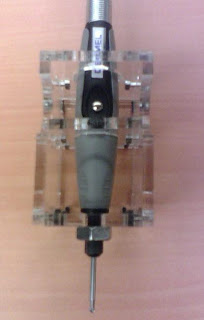My senior design project was to compete in a rudimentary car crash modeling also known as a crash cage competition with a partner. The goal was to design a cage, which represented a car frame, that had to protect a passenger compartment from an initial crash impact and the engine after impact. The passenger compartment was represented by a empty 6 cm by 6 cm box. The engine was represented by a 6 cm by 6 cm solid box. The crash was simulated by dropping the cage from about a 2 meter height with a weight on top of it. The cage would slam into the ground, and the engineering design aspect of the project was to design it such that it crumpled in a way we desired, utilizing energy dissipation and crumple zones.
 |
| One of the crash cages I designed in SolidWorks. |
The metal we used was aluminum and steel so knowing there mechanical properties were essential. We were only allowed to use cylindrical cuts and legs of the metal as shown in the model below. It took many iterations to arrive at our final design. We simulated the crash (drop) using by analyzing nodes in MatLab. Using the mechanical properties such as elastic modulus, plasticity, and strength, we performed energy calculations to determine how our cage would deform after the impact. Some of the results are displayed below.
 |
| MatLab Nodal Analysis of a part of the Cage. Red is the original position of the nodes, and Blue is the deformed position. |
After analysis showed sufficient energy dissipation in areas that we wanted to absorb energy, we took our SolidWork's model and built the crash cage cutting and drilling all the necessary pieces in the machine shop.
 |
| The fully assembled version of the crash cage. |
During the actual competition when we were dropping the cages, our two cage designs places 1st and 2nd. Ours dissipated the most energy while keeping the passenger compartment safe. It was a very fun event, made even funner by the fact that we came in first place. We really spent our time analyzing the designs in MatLab to ensure our success.











